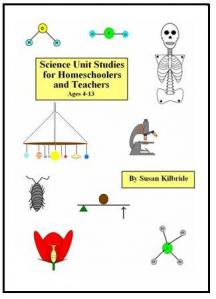Science Unit Studies for Homeschoolers and Teachers has 20 lessons, 10 for children ages four through seven, and 10 for ages eight through thirteen. While lessons could be done with a single child, they involve gathering and preparing quite a few resources, work that’s more practical when done for a family or group class. I expect that you will use each set of ten lessons in a different year since they target different audiences. Both sets of lessons address life, physical, and earth science topics. While it might be best to use the chapters in order since they build upon one another to some extent, many parents and teachers will want to switch the order and that should also work fine.
Each of the 20 lessons has up to eight parts, each of which should take at least one class period to complete. Some such as growing plants in chapter 9 and the research report in chapter 12 might take significantly more time. This is a unit study approach in that each chapter concentrates on aspects of a single topic using various learning style methods, although hands-on activities clearly are predominant.
With younger students, you could work through the lessons, using this as your primary science resource. Lessons include instructional information along with many hands-on activities—a great way to teach science. Occasional, a supplementary resource such as a “Magic School Bus” video is recommended for additional content or reinforcement.
Older students, especially at junior high level, will need more content, in which case, Science Unit Studies could be used to supplement a core resource. Many science textbooks or real book approaches could use the depth and variety of activities provided here, so combining this with another resource should work very well as long as they address similar topics. The last ten lessons each conclude with ten-question, multiple-choice tests that will help provide accountability. Answers are at the back of the book.
Both activities and content in the upper level lessons are sometimes very challenging for third or fourth grade students. Discussions of positive and negative charges for atoms, electron valences, work with a microscope, introduction of the W=FxD (work equals force times distance) equation, and the aforementioned research paper might need to be reserved for older students. I would probably have suggested younger level lessons for up through ages eight or nine and reserved higher-level lessons for at least ages nine or ten. Using so many hands-on activities does allow the introduction of more complex concepts to younger children. They might not fully understand, but they are at least introduced to the ideas. You will have to judge what is appropriate for the students you will be teaching. Chapters nine and thirteen are available as free samples on the Funtastic Unit Studies! Website so you can preview before buying.
Activities require many resources, although most will be inexpensive and easy to obtain. At the upper-level, one lesson requires a microscope and microscope accessories. Be sure to plan far enough in advance to gather, order, borrow, or purchase these and other resources.
The book is available in either paperback or ebook format, but from different sources for each.
Note that chapter three teaches about dinosaurs and prehistoric life referring to millions of years. If you have a different viewpoint, you can still use this chapter by simply changing the time period references since there are only a few. Otherwise, there is nothing I spotted that reflected a particular worldview.









